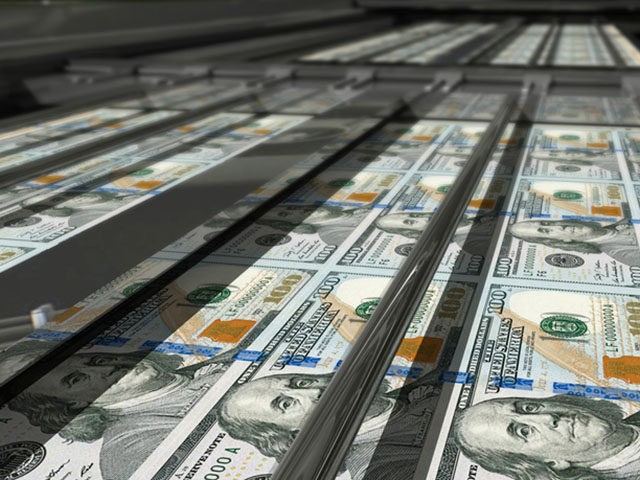It was only five months ago that the U.S. trade deficit in goods hit a record high of $125 billion. Now we’re all the way down to $87.4 billion.
This was the fifth monthly decline for the trade deficit in goods. Exports declined in August, falling 0.9 percent compared with July. Compared with a year ago, however, exports are up 20.8 percent. Imports fell 1.7 percent in August but are up 13.1 percent year over year.
The numbers, however, are nominal. Export prices fell 1.6 percent in August, according to the Bureau of Labor Statistics. So the August decline is likely a real gain after inflation adjustment. For the year, export prices are up 10.8 percent, meaning about half the gain in exports is from higher prices rather than more goods.
The decline in exports was driven by a 3.5 percent decline in a category called industrial supplies, which includes petroleum exports. Export prices of industrial supplies fell by the same 3.5 percent; so it’s possible that real exports were flat for the month. Auto exports fell sharply, declining 8.9 percent. Export prices were flat for the month. It’s likely that the strong dollar, which hit a 20-year high in August, priced foreign consumers out of the market for U.S. autos, illustrating how exports are forced to bow to King Dollar when he rises.
The decline of imports was also driven by a big 6.9 slump in industrial supply imports. That’s likely due to the fall in oil. Imported petroleum and petroleum product prices fell 7.1 percent, and crude oil prices fell 7.3 percent, according to the Bureau of Labor Statistics. Imports of autos rose 3.8 percent, a real gain as prices of imported autos fell 0.1 percent. Capital goods imports—the largest category of imports in the Commerce Department’s Advance Economic Indicators report—fell 1.8 percent. Capital goods import prices were flat for the month, so this wasn’t a strong dollar story. Instead, this likely reflects some hesitancy on the part of U.S. business to make capital expenditures at a time of high economic uncertainty.
Advance Economic Indicators report also includes data on wholesale and retail inventories. Wholesale inventories rose 1.3 percent, a big increase over the 0.4 percent expected. Retail inventories rose 1.4 percent, above the one percent expected. This rapid inventory accumulation could be a sign that businesses are feeling bullish about sales this fall. Or it may be a sign that back-to-school sales were slower than expected, leaving more product in the warehouse. These numbers are also nominal, so some of the build simply reflects rising prices.
A shrinking trade deficit and growing inventories are positives for Gross Domestic Product. Bank of America said after the report came out on Wednesday that its GDP tracker move up from 0.7 percent growth for the third quarter to one percent growth. The Atlanta Fed’s GDPNOW tracker is likely to be revised up at its next release on Thursday. It is currently at 0.3 percent growth for the third quarter.
Some quick bullet points on other developments:
• Pipe dream: The Nord Stream pipeline explosions likely mean that the price of oil will go up because Europe will need more of it to substitute for lost natural gas. Natural gas prices probably will go up as well. This could be a net positive for the U.S. because we export both. It is bad news for Europe’s economy, although how bad will depend on how cold it gets this winter. Basically in Game of Thrones zone: winter is coming.
• Hurricane Ian: In general, hurricanes depress the local economy in the short term (i.e., demand falls as locals evacuate, production drops as businesses close), but most of that gets made up for later, especially because the federal government starts spreading around disaster relief money. Hurricanes also tend to be a positive for home improvement stores, which make a lot of sales as the rebuild begins. A big hit could be mildly inflationary because people will have to spend a lot to replace damaged goods.
• Home Is Where the Three Percent Mortgage Is: Pending home sales fell by more than expected in August, but this is as much a supply story as a demand story. People do not want to sell their homes because they’d be trading, say, a 3 percent mortgage for a 6 percent mortgage, so inventory is low. Some back of the envelope math shows that the monthly payment on a 2.75 percent 30-year fixed mortgage on an $800,000 home would be around $4,404. At seven percent, that mortgage payment goes up to $6,409. A mortgage on a $600,000 house at seven percent will run $4,627 a month. Sales will keep falling, and eventually prices will have to fall to accommodate higher mortgages rates.
We’ll get another report tomorrow on monthly jobless claims. These have been firmly planted at a very low level, an indication that Fed tightening has not yet made a big impact on labor demand. One of these weeks we will likely see some significant upward pressure. But, as they say, monetary policy acts with a long and variable lag, so no one can say when that will be.

COMMENTS
Please let us know if you're having issues with commenting.